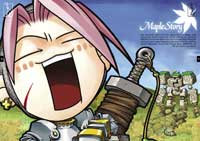
Vol. VII, No. 6, November-December 2007
- Editor's corner
- The changing nature of leisure time
- Who has time to wait?
- Online karting arrives
- Foundations Entertainment University registration is open
- Road kill stew
- Review of IAAPA show in Orlando, Florida
- Grandparent spending
- Free white papers for e-mail marketing
- Death to the black box, hello daylight
- Hurray for pizza
- The relationship of education to income
- Get real, this is a place for children?
- Update on uWink
Online karting arrives
Go-kart facilities beware! There's a new kid on the block, and your customer doesn't even have to leave home for the thrills and chills. Read on to learn more about KartRider and other multi-player online games that are becoming your hottest competition.
Away-from-home entertainment venues are in constant competition with in-home entertainment. It takes far less effort to sit in the lounge chair and watch a high-definition DVD on a big HDTV, or to grab the game controller and go at it, or cruise the Internet than to take extra time to go out to some entertainment venue.
We are constantly monitoring what is happening with in-home entertainment. If location-based leisure (LBL) venues don't know what the competition is up to, they cannot evolve to stay competitive. The Internet is having a dramatic impact on in-home entertainment, now that high-speed cable and DSL service are available in more and more homes. It has opened up the availability of multi-player games, many that could even classify as social games.
These games are both MPOG (multi-player online games) and MMORPGs (massively multi-player online role-playing games) where hundreds of thousands of players create their own characters and partake in adventure, historical fantasy or other type games. Research firm DFC Intelligence expects the global online gaming market to grow to $13 billion in 2011 from $3.4 billion in 2005. North America, Europe, and Japan, where most gamers grew up playing on consoles, are expected to offer a significant growth and to account for $9 billion in online game revenue in 2011.
 Watch out go-kart facilities, KartRider MMORPG is coming to your customers' home computer screens not only to grab a slice of their leisure time, but also to take some of their disposable entertainment dollars. This popular South Korean online, multiplayer racing game is an overseas phenomenon with 160 million fans. Now KartRider is planning to launch in the U.S.
Watch out go-kart facilities, KartRider MMORPG is coming to your customers' home computer screens not only to grab a slice of their leisure time, but also to take some of their disposable entertainment dollars. This popular South Korean online, multiplayer racing game is an overseas phenomenon with 160 million fans. Now KartRider is planning to launch in the U.S.
KartRider is free to play, but derives revenue from microtransactions. If players want to give their character a haircut or customize their cutesy little kart with a new color paint, it costs from 25¢ to $10 per digital download. There are more than 300 virtual items for sale. You will even be able to purchase prepaid KartRider gift cards at Target and other major retailers.
The ability to customize something you own, whether it is real or virtual, is a powerful motivator. It is one of the reasons Starbucks is as popular as it is - 10,000 ways to customize your coffee just the way you like it.
 Microtransactions are new to the U.S. To date, the phenomenon has been driven predominately by Xbox Live Marketplace. Xbox players have downloaded more than 290 million pieces of gaming and entertainment content. Another online game, MapleStory, already has four million registered users in the U.S. who have spent $1.6 million on 600,000 microtransactions in one month alone.
Microtransactions are new to the U.S. To date, the phenomenon has been driven predominately by Xbox Live Marketplace. Xbox players have downloaded more than 290 million pieces of gaming and entertainment content. Another online game, MapleStory, already has four million registered users in the U.S. who have spent $1.6 million on 600,000 microtransactions in one month alone.
As this online phenomenon grows in popularity, we may reach the point where the younger generation, especially Generation Y (children born between 1981 - 1995), doesn't see any difference between the virtual entertainment world and bricks and mortar entertainment venues. It is fast coming down to the battle of leisure time and dollars in the real world versus leisure time and dollars being spent in the virtual world. And with the ego gratification from customization offered through microtransactions and the social networking MMORPGs provide, the virtual world could easily end up being the preferred entertainment experience for the younger generation.
Vol. VII, No. 6, November-December 2007
- Editor's corner
- The changing nature of leisure time
- Who has time to wait?
- Online karting arrives
- Foundations Entertainment University registration is open
- Road kill stew
- Review of IAAPA show in Orlando, Florida
- Grandparent spending
- Free white papers for e-mail marketing
- Death to the black box, hello daylight
- Hurray for pizza
- The relationship of education to income
- Get real, this is a place for children?
- Update on uWink



